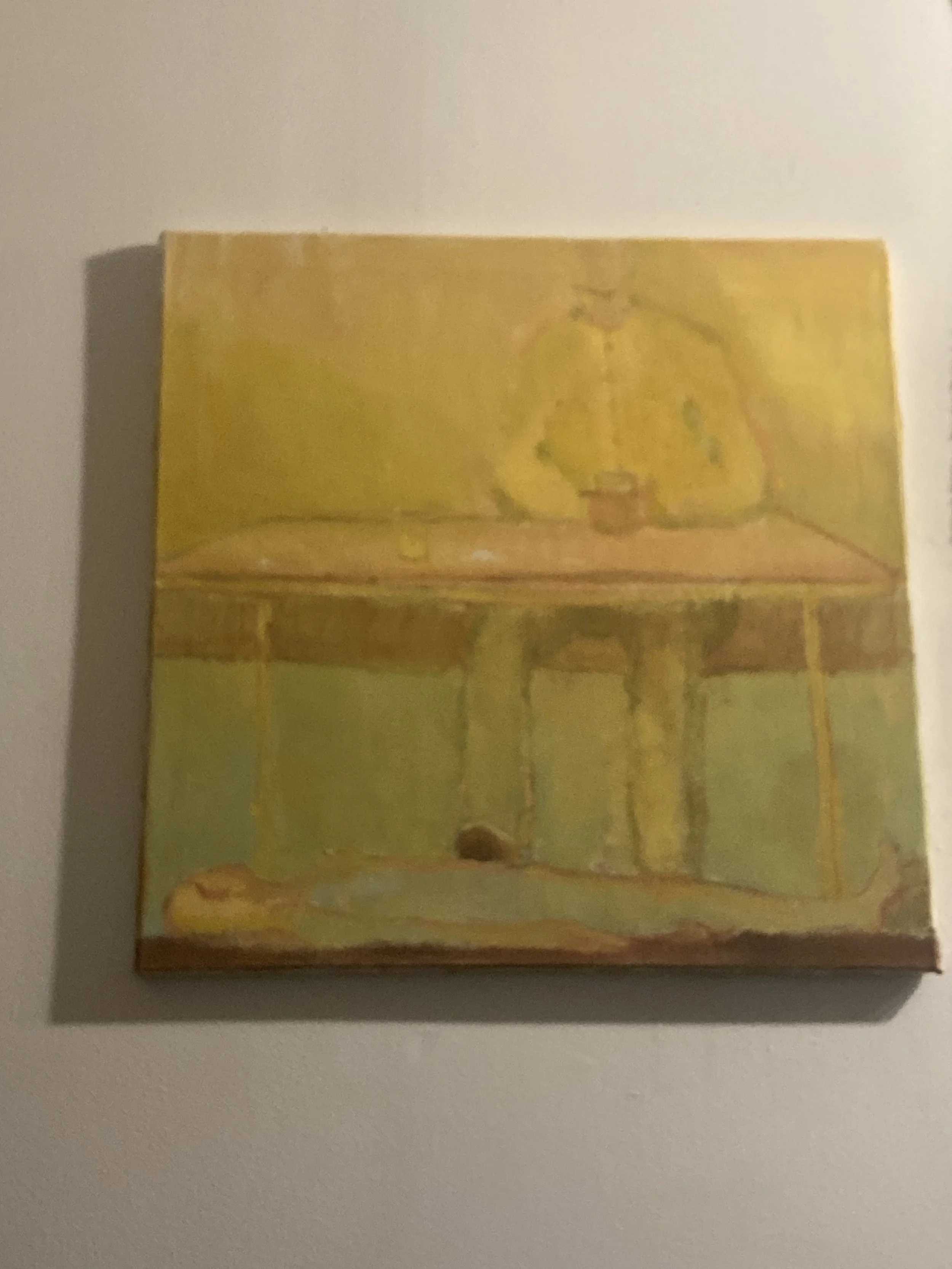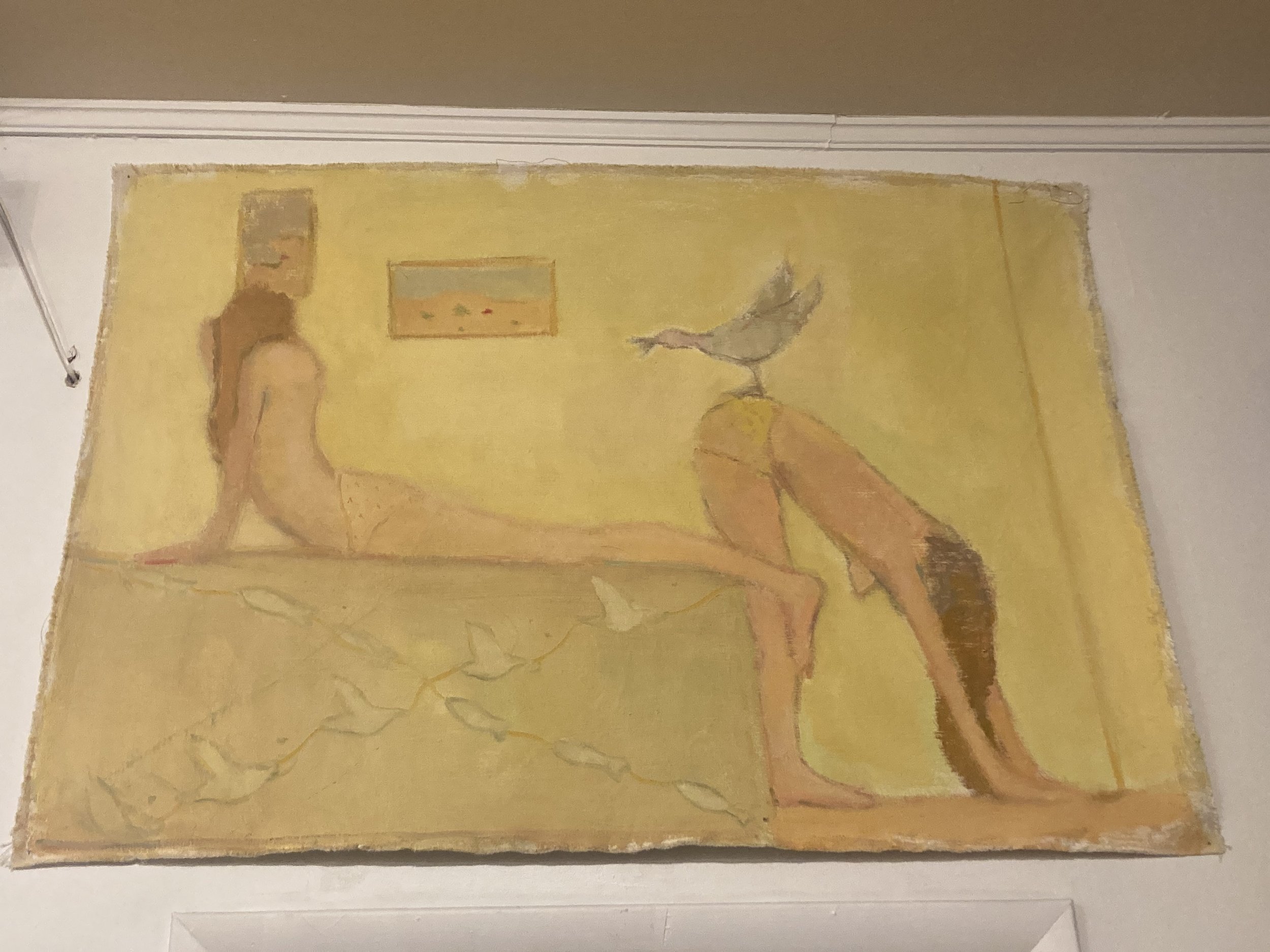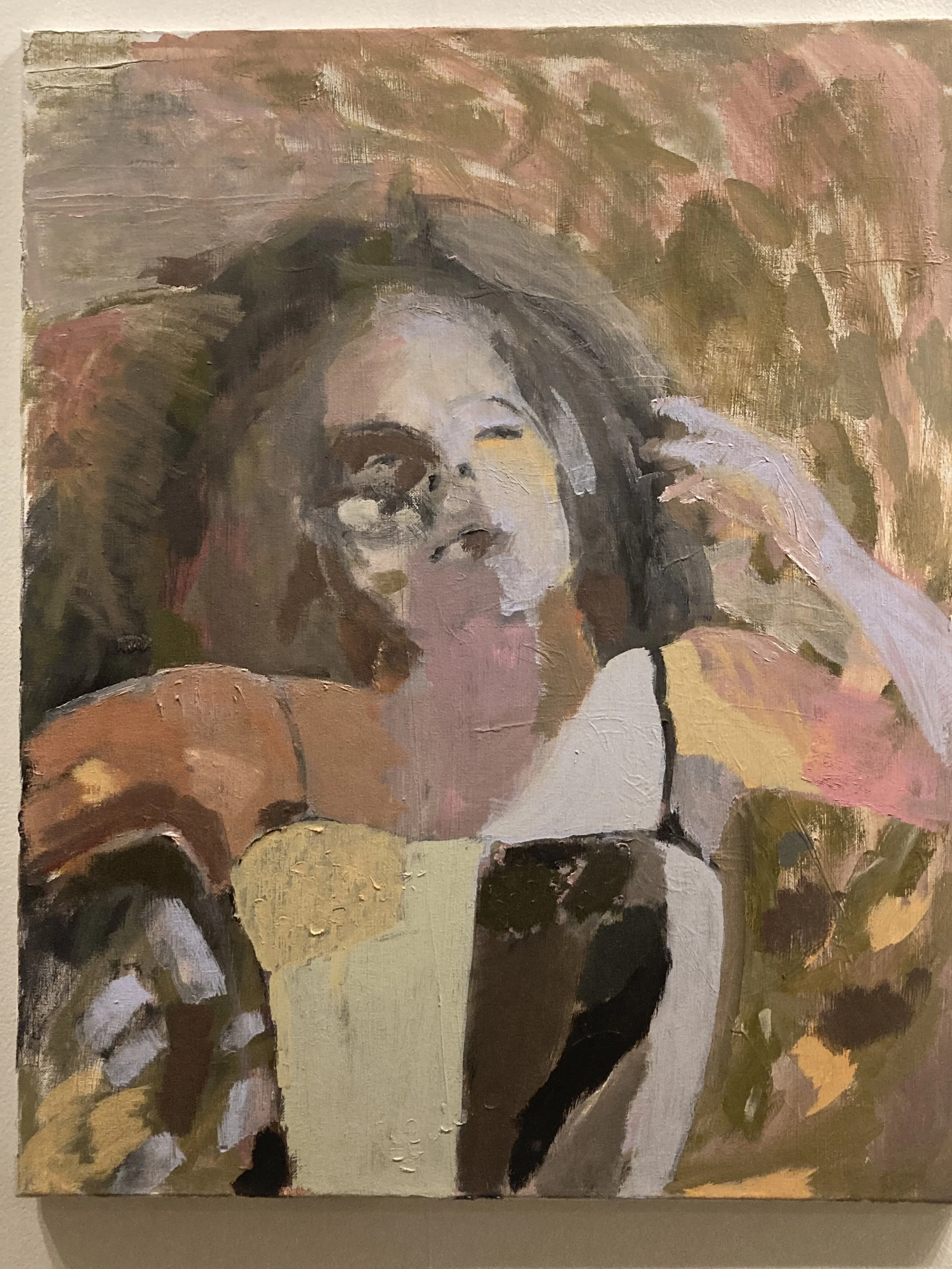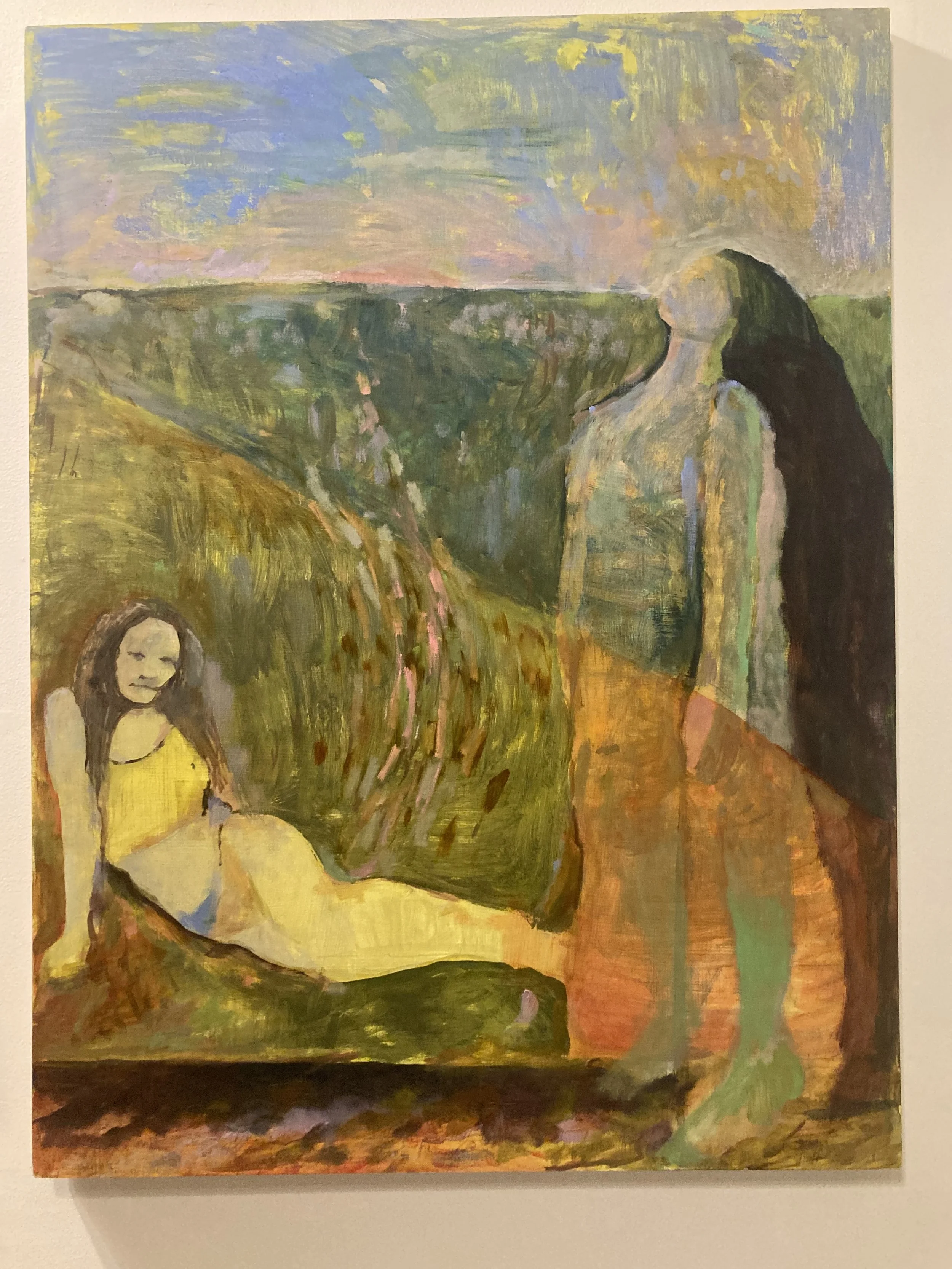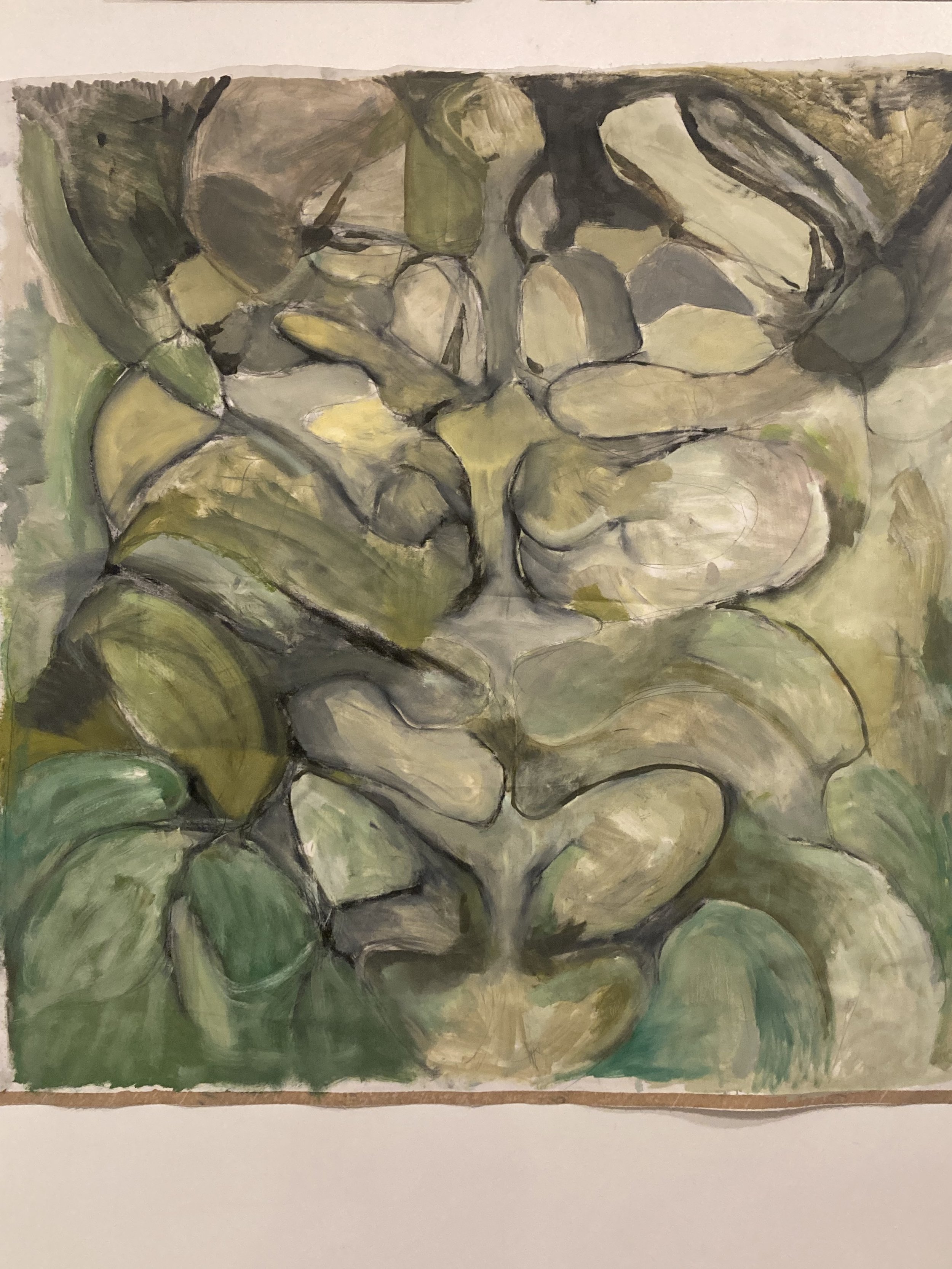Marley Edelman and Eva Kozlowski Art Show at Launderette Records
On Friday, March 1st, Launderette Records in Port Richmond hosted a DIY art show featuring Pennsylvania Academy of the Fine Arts alumni Eva Kozlowski and Marley Edelman. Showcasing both past and recent works centered on introspective themes, the artists delighted a sizable crowd of citywide art-community members and supporting locals. Mutually acquainted since their days at PAFA, Kozlowski and Edelman envisioned the space as an ideal venue for showcasing their distinctly unique and personal styles.
Making their way around the room, visitors came across one of Kozlowski’s bright and painterly pieces entitled Sofie and Eva Leaning on Each Other. An eye-catching piece featuring oil on canvas, the painting drew the eyes of visitors thanks to its diffusive use of yellow hues that frame the picture in a smooth and sedate manner. As its focus, the image features two nude women, their backs to one another with their legs gently splayed. The women seem like mirror images of each other, their torsos taut and arms spread at a 90-degree angle. Their hands are clasped and intertwined while their heads bow down, chin-to-chest as if emulating a sacred pose. Braided hair falls down each of their shoulders and hangs off their bodies. The woman on the left is blonde with pinkish-white skin, while the woman on the right is a brunette whose darker skin calls to mind a subversion of the ancient tradition of illustrating the male-female dichotomy as a contrast between dark and light hues. In this picture, however, it’s the female form that takes precedence, as is the unbroken bond between both subjects. A yellow butterfly hovers above them, wings spread, while two additional butterflies appear framed within the space between the women’s arms and bodies. Flying towards the women, one can notice two white doves, each also a mirror image of the other, and each carrying what appears to be a laurel leaf. At their feet, there are hints of green and brown that commingle with the yellow notes that frame the scene. Yellow rays emanate skywards from above the women’s clasped hands in a symmetrical way, while an arrangement of roses and yellow lilies enhances the painting’s themes of life-affirming companionship.
Another of Kozlowski’s paintings entitled Stop Kicking Me Under the Table, similarly features yellow as a motif. This time, however, Kozlowski uses subtle splashes of pink and orange to heighten the painting’s themes of oppression and melancholy. In the foreground, we see a table, sporting a light-red top with nuanced blotches of white. Two bar glasses sit on it. One, situated on the left third of the composition appears half-empty. The other is carefully clutched by a faceless man. His clothes resemble the painting’s color scheme: vivid yellows with hints of green and gray. Casually sitting on a bench, his face is obfuscated by pink dashes that bestow on him a degree of total anonymity. His right foot is set on a woman’s torso. Her body seemingly inert, rests on the floor at the bottom of the frame. Her arms lay rigidly to her side, while her blonde hair and pinkish face seem to turn away from the viewer’s meddling gaze. Splayed nude on the ground, the man’s foot pressing on her abdomen, the woman simultaneously calls to mind themes of vulnerability and defiance. Adding to the painting’s emotional intensity, the contrast between yellow and green at the top and bottom thirds of the picture is heightened by the bench’s dusty redness. As a result, one can’t help but share the woman’s sense of entrapment while admiring her determination to look away in open defiance. Nor can one help but admire Kozlowski’s economy of color which deliberately contrasts conflicting emotions while marvelously grounding her subjects. It’s part of Kozlowski’s calculated method, as she employs no more than four different colors in each of her paintings to conjure up and make sense of images produced by her mind’s eye.
In a third painting entitled Oh, Memory, once again, we notice the interplay of green and yellow. And once again, Kozlowski methodically places these colors throughout the painting. In this case, we get a view of two women inside a bedroom. The woman to the left of the painting peacefully reclines on a bed in what seems like a down-dog yoga pose. Propping up her upper body with both arms, her face hides from view. Her hair, luscious and brown cascades down the sides of her left arm. She’s almost nude, wearing only her underwear. Her feet hang from the bed on which we notice yellowish and greenish sheets embroidered with pictures of white doves. To the right of the picture, the second woman is likewise engaged in a yoga pose. She’s similarly just wearing underwear- yellow with reddish dots- and her body is in an up-dog position: legs straightened, torso carefully leaning forward, her arms stretched down to the floor. Her nude breasts are showing, while her head faces downward, her hair flowing freely earthbound. A seagull perches casually on her tailbone honking and fluttering its wings as an unexpected yet active participant in this otherwise quotidian milieu.
Alongside Kozlowski’s tranquil and contemplative compositions, visitors also got an opportunity to admire Edelman’s expressionist and likewise self-examining works. One of Edelman’s more conspicuous paintings entitled Girl on the Floor in Thought, features a young woman seemingly mid-gesture. Her neck is somewhat turned to her left, her left arm and hand, in turn, guiding the viewer’s gaze toward the right side of the painting. It’s hard to say whether the woman is in the process of covering up her face or opening up her arms. At this precise moment, she seems frozen in time, her poised black eyes focused beyond the frame’s boundaries. She inhabits a swirling vortex of colors: greens, grays, pinks, whites; her face fragments of seemingly opposing emotions underscored by touches of black, tan, white, and gray. Her dress also stands as a testament to a dual existence: black and white evenly halved down the length of her body. The composition made of oil and paint involved a meticulous process on Edelman’s part. Starting as a self-portrait, Edelman then opted to paint a picture from a magazine onto the existing image. The tension in the composition thus captures the multifaceted nature of both the artist and subject(s), as subjects, color, and form seem to coexist in harmonious conflict.
Another of Edelman’s paintings made on canvas and wood, entitled Two Girls in the Grass features two women in a pastoral setting. On the right side of the frame, we notice a woman standing upright, arms to her side, her face and chin facing defiantly upwards. Her long black hair flows down her back, her body carefully dissected by a diagonal line that contrasts the cooler tones on her face and chest with the warmer colors that define her earthbound-flowing skirt. The second woman, in turn, sits casually on the left side of the picture, her body resting on her right arm pitched against the ground while her eyes look back questioningly at the viewer. The scene is bucolic and carries a casual hint of spirituality. Both bodies appear lost to the power of the moment, progressively melding into the painterly strokes of pink, white, blue, and green that carefully define the setting. The result of drawing photos of herself and subsequently projecting them onto the canvas with a loose trace before allowing her imagination to take the lead, the painting aptly reinforces Edelman’s diligent and premeditated process. For Edelman, the tracing of photographs onto the canvas allows her to ground the picture and concentrate on the suggestive power of color over images. It also allows her to more ably express recurrent motifs of memory and self, female bonds, and her relationship with women existing in a variety of different spaces.
A third piece entitled Breathing, is inherently more abstract. Drawn with charcoal, it is a pleasant study of color and form. For the piece, Edelman chose not to limit herself by composition, focusing instead on line weight to induce feelings in the viewer. The result is a captivating combination of undulating shapes rising to the top of the frame punctuated by a dialectical sequence of greens, grays, and blacks that lend the piece an element of in-the-moment three-dimensionality as if one were watching the act of creation itself breaking into blossom.
Different as their styles are, Kozlowski and Edelman both belong to a generation of young local artists whose artistic roots were nurtured in the country’s oldest art institution. Hailing from Moorestown, New Jersey, and South Florida respectively, both artists embody a sense of passionate optimism about their futures that’s equally complemented by a strong sense of community and self-reliance. It was Edelman who reached out to both Kozlowski and Launderette Records owner Mike Vee about using the space as a way to engage the local community with the burgeoning DIY art scene.
In retrospect, Edelman’s choice of venue made a lot of sense. Vee’s space has been actively engaged in the local art scene, hosting various art shows every couple of months. Vee’s longtime friend Scott Cooper has been acting as the record store’s curator since Lauderette Records’ third art show in 2022. A longtime member of Philadelphia’s underground punk scene, Cooper started working pop-up shows for the Phily-based art market Vicarious Love in 2014. The ensuing collaboration between different like-minded members of the city’s art community thus stands as a testament to the various talented voices in the region looking to engage with both small-business owners and the general public. For the artists involved, the event was not just a step towards building meaningful connections in the community. Their work, which can also be purchased, will remain on the record shop’s walls for a couple of months adding a bright human touch to one of the river ward’s numerous thriving locales.

